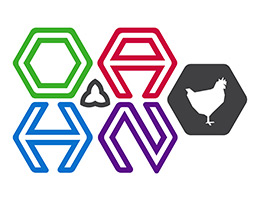Ontario Animal Health Network (OAHN)
Poultry Expert Network
Quarterly Producer Report
Gangrenous Dermatitis in commercial poultry
Emily Martin and Emily Brouwer
In every quarter since Q4 2023 (September to November 2023), the AHL has received multiple cases of broiler breeder chickens with increased mortality and skin lesions. The skin changes vary from mild congestion and subcutaneous edema to marked discolouration of the skin (red-purple), edema, and crepitus (Figure 1). Bacterial culture of subcutaneous swabs identified various combinations of C. septicum, C. perfringens, Staphylococcus aureus, E. coli and E. cecorum. The presence of Clostridium sp. combined with histologic lesions was consistent with a diagnosis of Gangrenous Dermatitis.
Gangrenous dermatitis can occur in both chickens (4-5 weeks of age) and turkeys (13-16 weeks of age) that are approaching market age. The economic impact occurs due to increased mortality, increased condemnations, and carcass downgrading. Mortality is usually 1-5% higher than unaffected flocks but can occasionally exceed this level (i.e. up to 60%).
Flocks present with sudden increased mortality. Clinically the birds are depressed, off feed, weak, ataxic and laterally recumbent. The most significant location for skin lesions includes the breast, back, abdomen, thighs, wings and tail (turkeys). The skin lacks feathers, can be dry or moist, and is discoloured dark red or green. Affected skin can have a range of lesions including edema, emphysema, and multifocal to coalescing hemorrhages that can extend into the underlying musculature. Carcasses rapidly autolyze. Microscopically, necrosis primarily occurs in the epidermis and dermis but can extend into the subcutaneous tissues and underlying skeletal muscle (Figure 2). The subcutaneous tissues have accumulation of serofibrinous exudate and emphysema. There are Gram positive rods noted throughout all skin layers and muscle. There is minimal inflammatory response.
The primary bacteria involved are either C. septicum, C. perfringens type A, or both. Numerous other aerobic or anaerobic bacteria can be isolated in combination with these clostridial species. These bacteria produce toxins resulting in the tissue necrosis described.
Environmental conditions and immunosuppression can interact to predispose to development of this disease. Environmental conditions include skin lesions (i.e. trauma due to cannibalism or fighting), stocking density, wet litter, poor ventilation, water leaks, and contamination (i.e. feed, water, equipment, vaccines). Immunosuppressive agents include IBDV, CAV, reovirus, IBH, and HE (turkeys).
The pathogenesis is not well understood with 2 theories of bacterial introduction. The first is skin trauma with external seeding of bacteria. The second is intestinal overgrowth of bacteria, loss of intestinal integrity, and systemic distribution of bacteria. Potential rule outs include contact dermatitis, mycotic dermatitis, bacterial cellulitis (non-clostridial), scabby hip (broilers) and focal ulcerative dermatitis (turkeys).
A presumptive diagnosis can be based on clinical signs, postmortem lesions, and histopathology. Subcutaneous swabs for aerobic and anerobic culture can be used to confirm this diagnosis.
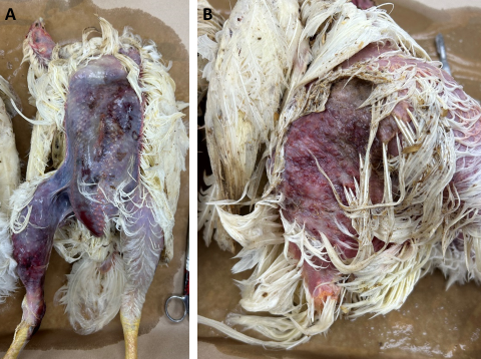

References
- Gornatti-Churria CD, et al. Gangrenous dermatitis in chickens and turkeys. J Vet Diagn Invest 2018;30:188-196.
Li G, et at. An outbreak of gangrenous dermatitis in commercial broiler breeders. Avian Pathology 2010;39:247-253. - Lighty ME, et al. Incidence of clostridial dermatitis (cellulitis) and factors for development of the disease in turkeys. L Appl
Poult Res 2016;25:104-112. - Opengart K. Gangrenous Dermatitis. In: Swayne DE, ed. Diseases of Poultry, 14th ed., Vol II. Wiley Blackwell, 2020:980-985.
Poultry Veterinarian Survey Highlights – Q3 2024 (Jun 2024 – Aug 2024)
Broilers
Overall, this quarter, the broiler flocks were in good health and most of the conditions were stable.
Practitioners
Stable conditions:
Early systemic bacterial infection (< 14 days old) related to E. coli, E cecorum and P. aeruginosa, lameness of developmental origin, ascites, coccidiosis, necrotic enteritis, infectious bursal disease (IBDV), infectious bronchitis (IBV), chicken anemia virus infection (CAV), spiking mortality, runting stunting syndrome (RSS), avian metapneumovirus infection (aMPV), condemnation issues (mainly subcutaneous and respiratory) and Salmonella.
Stable to increased conditions:
Other causes of mortality related to IBH infections and lameness of bacterial origin.
Stable to decreased conditions:
Late systemic bacterial infection (> 14 days old) related to E. coli and E.cecorum, as well as lameness of nutritional and viral origin.
Equally stable, increased, or decreased conditions:
IBH affecting chicks in their early age stage (3 weeks old) with 7-10% mortality.
Percentage of E. coli resistant to TMS this quarter was between 17 and 33%.
Frequency of conditions seen in the flocks:
Common: Early and late systemic bacterial infection, lameness of bacterial origin.
Common or rare: IBH, IBV, lameness of viral origin and condemnations.
Rare to not seen: IBDV, lameness of developmental and nutritional origin, other causes of mortality (heat prostration at the end of the growing period), ascites, coccidiosis, necrotic enteritis, spiking mortality, RSS, salmonellosis and aMPV.
Not seen: Histomoniasis, ILT, CAV and Avian Influenza.
AHL
Similar number of cases (from previous quarter):
Lameness developmental (tibial dyschondroplasia).
Coccidiosis (small intestine).
Necrotic enteritis.
RSS – Suspect.
Increased number of cases (from previous quarter):
Early systemic bacterial infection (< 14 days old) – Most cases had E. coli isolated either in pure culture or in combination with E. cecorum, or P. aeruginosa. One case of E. faecalis isolated in pure culture.
Other causes of mortality (> 14 days old) – Mycotic pneumonia, dehydration and stargazing chicks (unknown cause).
Lameness nutritional (rickets).
Lameness bacterial (Primarily diagnosed on histology) – E. coli isolated either in pure culture or in combination with E. cecorum. P. aeruginosa isolated in pure culture. Also, osteomyelitis in long bones and vertebrae.
Lameness viral (Reovirus confirmed: SK_R12, ON_variant_H_18-008168, Pennsylvania 13-095523, ON_variant_A_12-073195, BC-17-0408-2017, and Georgia 13-097066).
Lameness viral (Reovirus suspicious, primarily diagnosed on histology).
Infectious bronchitis (IBV – pathology cases and PCR positive)( Field strains: IBV_DMV_ON_21-017385. Vaccine strains: IBV_Conn, USA Mass-AHL 21-008165, and IBV_Mass-MA5.)
Avian metapneumovirus.
Condemnation issues (Condemned livers: Granulomatous hepatitis (Aeromonas veronii, Vagococcus fluvalis). After defeathering – severe cutaneous ulceration (lower back)).
Infectious bursal disease (pathology cases).
Decreased number of cases (from previous quarter):
Late systemic bacterial infection (> 14 days old) – All cases had at least E. coli isolated either in pure culture or in combination with E. cecorum, or P. aeruginosa.
Inclusion body hepatitis (FAdV08b_AHL_16-049095_ON, FAdV08b_AHL_18-057921_ON, and FAdV11_USA_1047).
Infectious bursal disease (PCR positive field strains: USA PA105-2014, USA 66-Indiana-2014, British Columbia 15-062782, and USA Del-E. Vaccine strains: UK Faragher 52-70).
RSS – Confirmed.
No cases diagnosed this quarter:
Spiking mortality.
Dead on arrival (DOA).
Other diagnostic findings:
Bacterial pneumonia, pulmonary mineralization, ingluvitis and heterophilic enteritis.
Salmonella:
Practitioners: The most common serotypes isolated were serotypes D with S. Kentucky listed with the clinical impression. Laboratory reports with detection of subtypes of S. Enteritidis, S. Kentucky and S. Alachua (graphs below).
Animal Health Laboratory Salmonella Isolations: Broilers (blue dashed lines indicate quarter periods: Dec-Feb, Mar-May, Jun-Aug).
Animal Health Laboratory Salmonella Isolations: Broilers
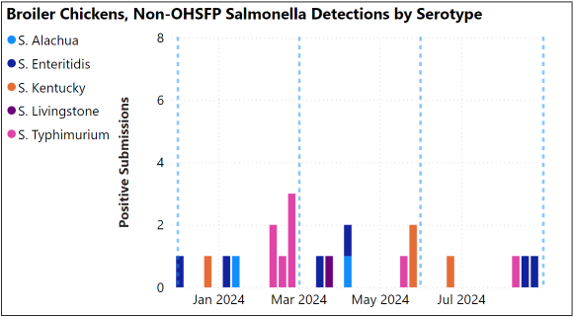
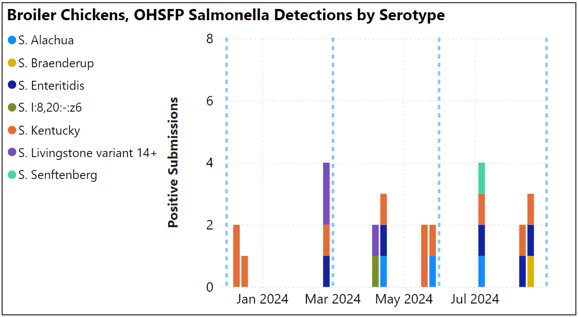
Condemnation conditions in provincial slaughter plants:
The top carcass postmortem condemnation conditions reported for June-August 2024 were contamination, ascites, cellulitis, and hepatitis.
Comparison of provincial condemnation conditions:
January-August 2023 (top) vs. January-August 2024 (bottom)
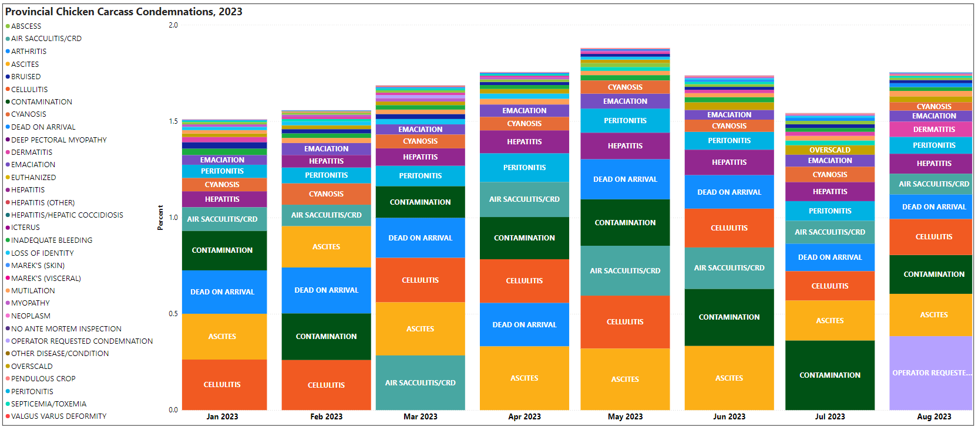
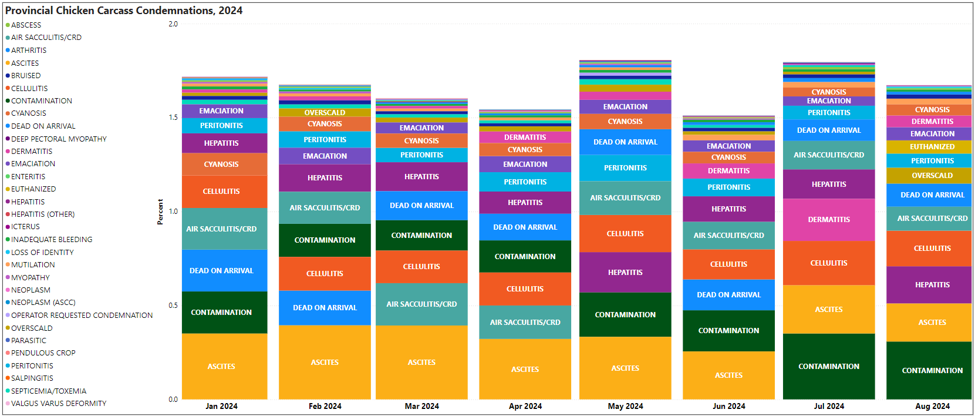

Number of chickens slaughtered by province, Jan-Aug 2024. From CAHSS Federally Inspected Slaughter Data.

Top 10 chicken post mortem condemnation conditions per 10,000 slaughtered by province, Feb-Aug 2024. From CAHSS Federally Inspected Slaughter Data. Subcutaneous conditions, abdominal edema, and liver conditions were reported as the main conditions for condemnation for chickens slaughtered in federally inspected plants in Ontario (dark green bars).
Broiler-Breeders
Overall, this quarter, the health status of the flocks was stable except increase in mortality and decreased production due to IBV infections.
Practitioners
Stable conditions:
Fowl cholera, other causes of early mortality, lameness viral/developmental/nutritional, inlay bacterial septicemia (E. coli, E.cecorum and G. anatis), necrotic enteritis, coccidiosis, fowl pox, ILT, multi-drug-resistant E. coli, lameness bacterial (mixed infections with E. coli, E. cecorum and Staphylococcus aureus), early bacterial infection (<14 days) and histomoniasis.
Stable to increased conditions: IBV (decreased productivity/abnormal eggs/sudden spike in mortality) and gangrenous dermatitis.
Stable to decreased conditions: Disease hatchability issues, salmonellosis, aMPV detections, mycoplasmosis (M. synoviae), aggression and cannibalism.
Frequency seen in the flocks:
Common to rare: Inlay bacterial septicemia and bacterial lameness.
Common, rare or not seen: Coccidiosis and early bacterial infection.
Rare or not seen: aMPV infection, disease related hatchability, fowl cholera, aggression and cannibalism, other causes of early mortality, lameness viral/developmental/nutritional, IBV (decreased production/abnormal abnormal eggs/sudden spike in mortality), necrotic enteritis, mycoplasmosis, multi-drug-resistant E. coli and histomoniasis.
AHL
Fowl cholera (Pasteurella multocida) – Occasionally isolated from lameness cases from vaccinated flocks.
Similar number of cases (from previous quarter):
Pododermatitis (S. aureus, E. coli, E. cecorum).
Trauma (humerus fracture).
Increased number of cases (from previous quarter):
Prelay morbidity/mortality (<20 weeks) – S. aureus was isolated in pure culture. The remaining cases had E. coli isolated in pure culture or in combination with E. cecorum as well as either G. anatis or P. aeruginosa.
Other prelay diagnoses included mycotic pneumonia, intussusception, emaciation/starvation and heat stress. Also, testing for CAV revealed multiple strains including CAV_ON_21-030998-0012, CAV_ON_19-042847-0003, and CAV_ON_22-064744.0003. Testing for IBDV revealed both a field strain (USA OH-Sel1-2012) and vaccine strains (USA Lukert, USA Del-E).
Inlay bacterial septicemia – E. coli and S. aureus were each isolated in pure culture, together, each with E. cecorum or all 3 together. E. cecorum and G. anatis were isolated together, with or without E. coli.
Lameness developmental (Valgus, tibial rotation).
Lameness bacterial – S. aureus, E. coli, and E. cecorum were each isolated in pure culture or in various combinations (S. aureus isolated with each or just E. coli/E. cecorum). All 3 are also isolated together with G. anatis with or without Avibacterium sp.. A case of osteomyelitis had E. coli isolated. There was 1 case of tendon rupture.
Coccidiosis – Identified in the small intestines (1 E. necatrix, 1 E. necatrix/E maxima), ceca, or both the small intestines and ceca.
Decreased number of cases (from previous quarter):
Early bacterial infection (<14 d old) – Cases had E. cecorum isolated in pure culture or in combination with E. coli.
Cellulitis/Dermatitis – E. coli isolated in pure culture.
Avian metapneumovirus (Concurrent infections: Bacterial osteomyelitis (skull), otitis externa, otitis interna, and septicemia).
Necrotic enteritis.
Intestinal parasitism – Histomonas, Capillaria, Ascaridia, and Heterakis.
IBV (decreased productivity/abnormal eggs/sudden spike in mortality) – (IBV_DMV_ON_21-017385, IBV_CA_1734_04_ON_12-025379, and IBV_Mass-MA5 vaccine).
No cases diagnosed this quarter:
Other causes of mortality (> 14 days old).
Bacterial pneumonia.
Lameness nutritional (rickets).
Lameness viral – Reovirus.
Fowl pox.
ILT and mycoplasmosis.
White Chick Syndrome.
Other diagnostic findings:
Gangrenous dermatitis (C. septicum, C. perfringens, E. cecorum; Clostridium sp.; C. perfingens, S. aureus; C. perfingens, S. aureus, E. coli; C. septicum, S. aureus, E. coli; E. coli, E. cecorum, S. aureus; C. perfringens, E. coli, E. cecorum, S. aureus, Bacteroides fragilis), celomic hemorrhage, lymphoid neoplasia, cannibalism, salpingitis (2 E. coli, 1 E. coli/E. cecorum, 1 histo), yolk peritonitis (2 E. coli, 1 histo), urate nephrosis/visceral urates and amyloidosis.
Salmonellosis (clinical)/Salmonella isolation:
Animal Health Laboratory Salmonella Isolations in Broiler Breeders (see graph bellow, blue dashed lines indicate quarter periods Dec-Feb, Mar-May, Jun-Aug):
No positive submissions outside of OHSFP testing (Ontario Hatchery and Supply Flock Program).
OHSFP environmental samples – S. Kentucky most isolated.
Three OHSFP excess mortality submissions with 5 serotypes detected (below).
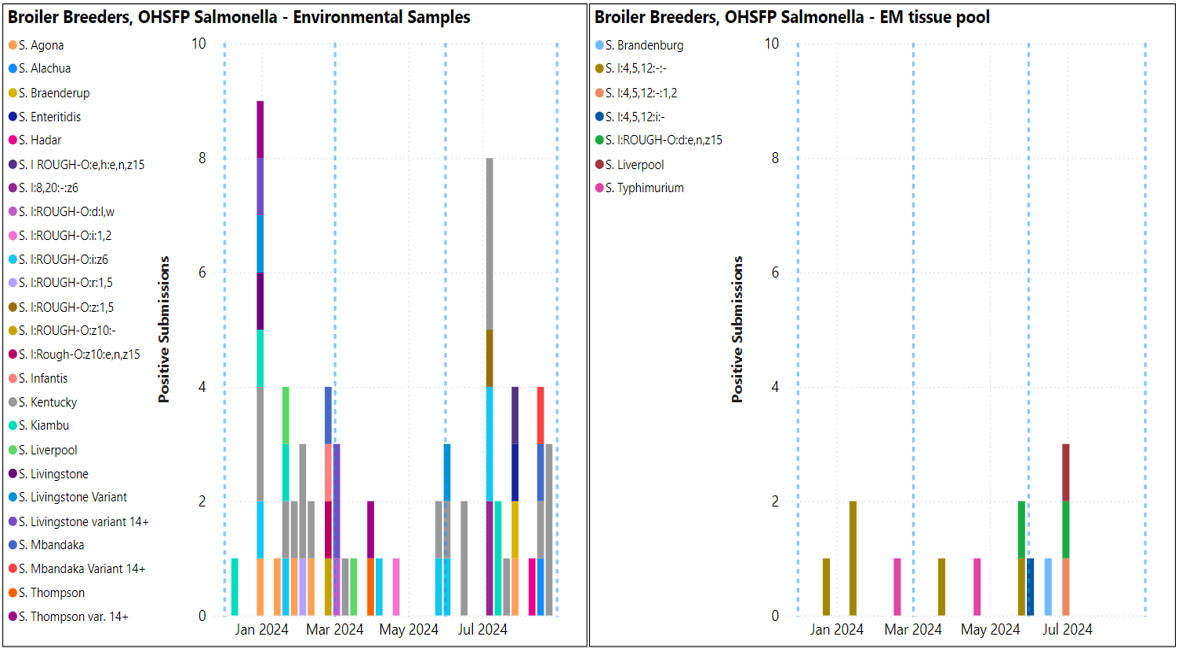
Layers
Practitioners
The same as last 2 quarters, veterinarians reported good, stable and solid health status for the past 3 months.
Stable conditions:
Osteoporosis, bacterial peritonitis/salpingitis, early systemic bacterial infection, other causes of early mortality, focal duodenal necrosis (FDN), ILT, mycoplasmosis (M. gallisepticum), hysteria, IBV (production drop/abnormal eggs/ respiratory) and salmonellosis, multi-drug-resistant E. coli and histomoniasis.
Stable to increased: aMPV infections had less impact this quarter on layer flocks, however more positive flocks were detected on serological testing. Affected flocks had a 2-3% reduction in egg production with up to 4 weeks period of recovery with normal mortality and culling rate. It was noted that aMPV infection contributes to increase susceptibility to IBV infection. Also, it was an increase in aggression and cannibalism during this quarter.
Stable to decreased: Coccidiosis and necrotic enteritis.
Frequency of detection in the flocks:
Common, rare, or not seen: IBV (production drop/egg abnormalities/ respiratory), osteoporosis, aggression, cannibalism. Focal duodenal necrosis was a common condition seen this quarter (primarily postmortem diagnosis, 1 case diagnosed on histology at AHL). Also, stress related conditions and new isolation of FAdv1 (see AHL data below).
Rare to common: Bacterial salpingitis/peritonitis (E. coli and S. aureus).
Rare or not seen: Early systemic bacterial infection, other causes of early bacterial infection, ILT, hysteria mycoplasmosis, coccidiosis (E. necatrix), necrotic enteritis and multi-drug-resistant E. coli.
Not seen: Clinical salmonellosis, ILT, avian influenza and histomoniasis.
AHL
New: Proventriculus and ventriculus having melenic content (black digested blood): Ventriculitis with Adenovirus inclusions (FAdVA – FAdV01 USA CELO field strain).
Similar number of cases (from previous quarter):
Infectious bronchitis (IBV – production drop/egg abnormalities/ respiratory) – (IBV_DMV_ON_15-077145, IBV_USA_GA08, and IBV_Mass-MA5 vaccine).
Avian metapneumovirus.
Increased number of cases (from previous quarter):
Early systemic bacterial infection (<14 old) – Septicemia and omphalitis.
Focal duodenal necrosis (FDN).
Coccidiosis (small intestine).
Decreased number of cases (from previous quarter):
In-lay mortality (>20 weeks) – Peritonitis/Salpingitis.
No cases diagnosed this quarter:
Prelay mortality (<20 weeks).
Other causes of early mortality (>14 d old).
Osteoporosis.
Leg issues – Trauma, bone fracture.
Leg issues – Bacterial.
Necrotic enteritis.
Intestinal parasitism (other).
Aggression/Hysteria.
ILT.
Mycoplasma.
Elevated DOA.
Other diagnostic findings:
Sinusitis, vaccine reaction, and USA D78 vaccine (IBDV vaccine).
Salmonellosis (clinical) / Salmonella isolation
Animal Health Laboratory Salmonella Isolations (graphs below, blue dashed lines indicate quarter periods Dec-Feb, Mar-May, Jun-Aug):
Layers: 1 positive submission outside of OHSFP (not shown, environmental samples, positive for S. Orion and S. Livingstone), no non-environmental OHSFP samples positive.
Layer breeders: No positive samples outside of OHSFP, no non-environmental OHSFP samples positive.
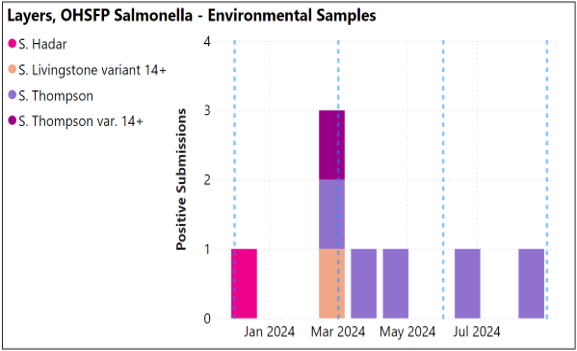
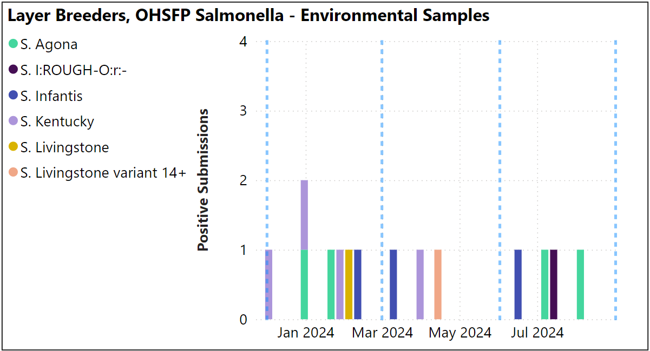
Turkeys
Practitioners
Turkey flocks continue to have health challenges, despite reduction in number of aMPV detections. Cases of histomoniasis, reovirus hepatitis, Streptococcus gallolyticus and E. coli infections were the most encountered conditions this quarter. E. coli and Ornithobacterium rhinotracheale (ORT) were the main contributors on the severity of clinical presentation of aMPV cases. It was noted that sick flocks with aMPV detection were in the vicinity of healthy flocks that continued to maintain the negative status.
Weak turkey cases: Between July 30 and September 6, 2024, ten cases of 4-7 week old turkey hens presented with weakness/neurological presentation having 10-80% morbidity and with a wide geographic distribution. Several tests and histology were performed on each affected flock with no specific pattern of lesions and no pattern of positive diagnostic tests identified between cases.
The lack of histologic lesions and lack of pattern to these lesions led to botulism testing (PCR). Only 1 case was positive for botulism toxin type C. Other testing included bacteriology (occasional organisms identified), avian influenza, Newcastle disease (APMV-1), avian metapneumovirus (aMPV), avian encephalomyelitis (AE), EEE/WNV, reovirus (1 case positive on brain, 1 case positive on hock swab), and feed testing (feed additive screen, salt screen on feed and brain, vitamin E and selenium). Case investigation is ongoing.
Stable conditions: Early systemic bacterial infection (E. coli and Salmonella), other causes of early mortality, late systemic bacterial infection (E. coli, S. aureus, E. cecorum and P. aeruginosa), enteritis, mycoplasmosis (M. gallisepticum), fowl cholera, erysipelas, coccidiosis, histomoniasis, round heart, aggression and cannibalism.
Stable to increased: Salmonella isolation, histomoniasis, multi-drug-resistant E. coli and aMPV (except one practitioner that reported decreased aMPV cases).
Stable to decreased: Reovirus tenosynovitis and necrotic enteritis.
Mycotic respiratory: Was mainly stable condition except one practitioner reporting decreased and another practitioner increased cases seen this quarter.
Frequency of conditions in the flocks:
Common, rare or not seen: Early systemic bacterial, late systemic bacterial infection.
other causes of early mortality, ORT, aMPV, enteritis and coccidiosis.
Rare or not seen: Erysipelas, mycotic respiratory disease, histomoniasis, necrotic enteritis, round heart, multi-drug-resistant E. coli, Salmonella clinical, reovirus tenosynovitis, aggression and cannibalism.
Not seen: Fowl cholera.
AHL
New conditions: Weak turkeys (see above).
Similar number of cases (from previous quarter):
Late systemic bacterial infection (>14 d old) – E. coli isolated in pure culture.
Bacterial pneumonia – E. coli, fibrinoheterophilic and heterophilic pneumonia.
Reovirus (PCR).
Increased number of cases (from previous quarter):
Mycotic respiratory disease.
Histomoniasis.
Tibial dyschondroplasia.
Decreased number of cases (from previous quarter): None.
No cases diagnosed this quarter:
Fowl cholera (Pasteurella multocida).
Erysipelas.
Early systemic bacterial infection (<14 day old).
Other causes of early mortality (<14 d old).
Avian metapneumovirus.
ORT (Ornithobacterium rhinotracheale).
Enteric disease.
Coccidiosis/Parasitism.
Necrotic enteritis.
Mycoplasma.
Rickets.
Condemnations.
DOA.
Other diagnostic findings:
Emaciation/dehydration, gizzard erosion, heterophilic enteritis/typhlitis, bacterial osteomyelitis, chondrodystrophy, botulism (Type C), and conjuntivitis/stomatitis.
Salmonellosis (clinical)/Salmonella isolation:
Practitioners: Reported stable to slightly increased. S. Hadar, S. Newport, S. Albany and S. Montevideo were listed as the main isolates.
Animal Health Laboratory Salmonella Isolations: Turkey – Meat
OHSFP – No detections.
Non-OHSFP: 5 submissions, 6 serotypes isolated (see below, blue dashed lines indicate quarter periods Dec-Feb, Mar-May, Jun-Aug).
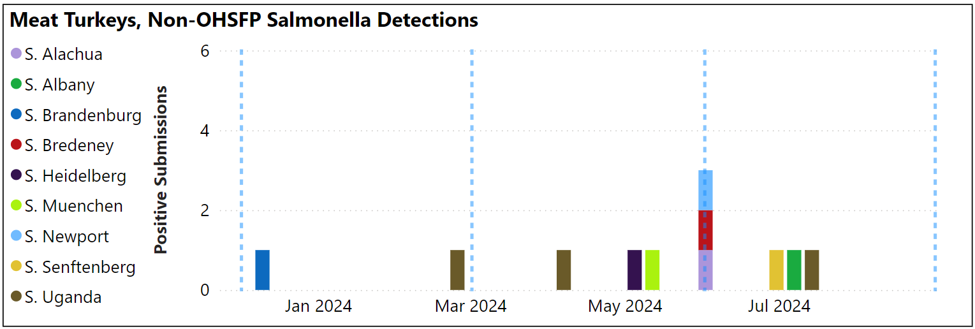
Animal Health Laboratory Salmonella Isolations: Turkey – breeders
OHSFP – All environmental samples this quarter with greater detections reported compared to the spring months.
Non-OHSFP – No detections.
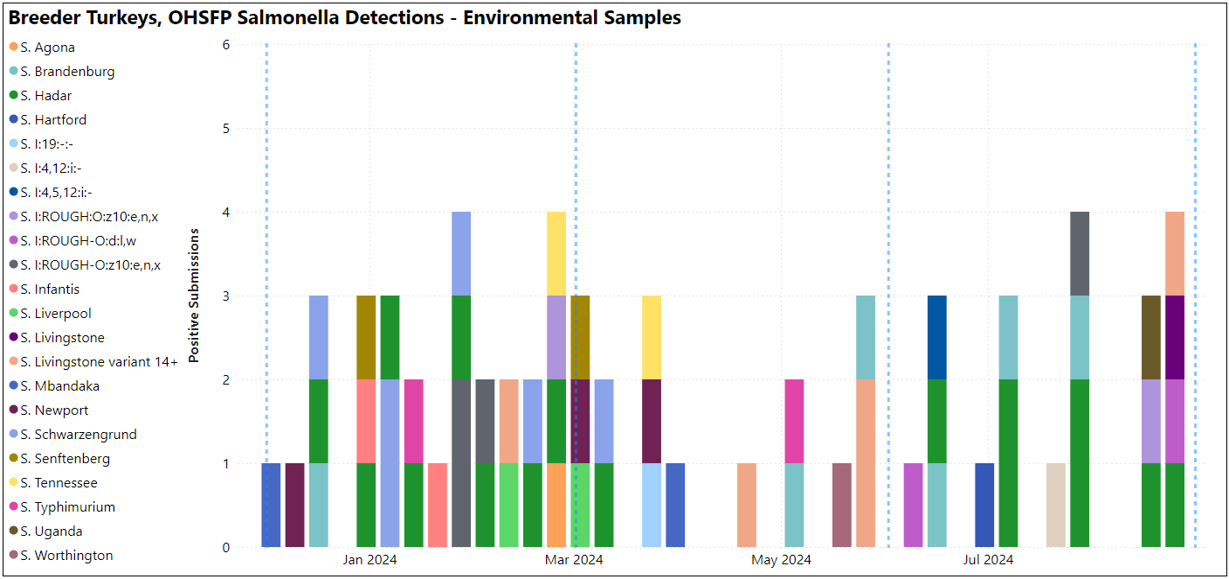
Provincial slaughter plants condemnations:
The top carcass postmortem conditions reported for June to August 2024 were airsacculitis, abscess, and peritonitis.
Comparison of provincial condemnation conditions:
January-August 2023 (top) vs. January-August 2024 (bottom)
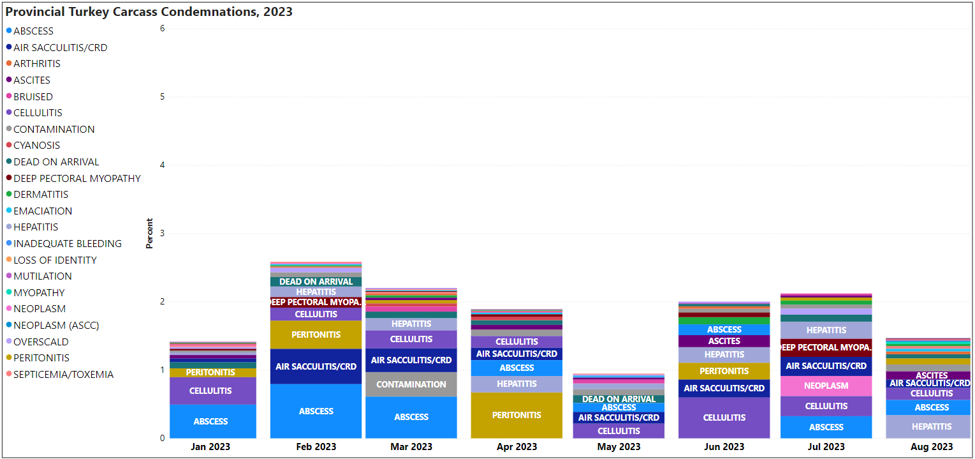
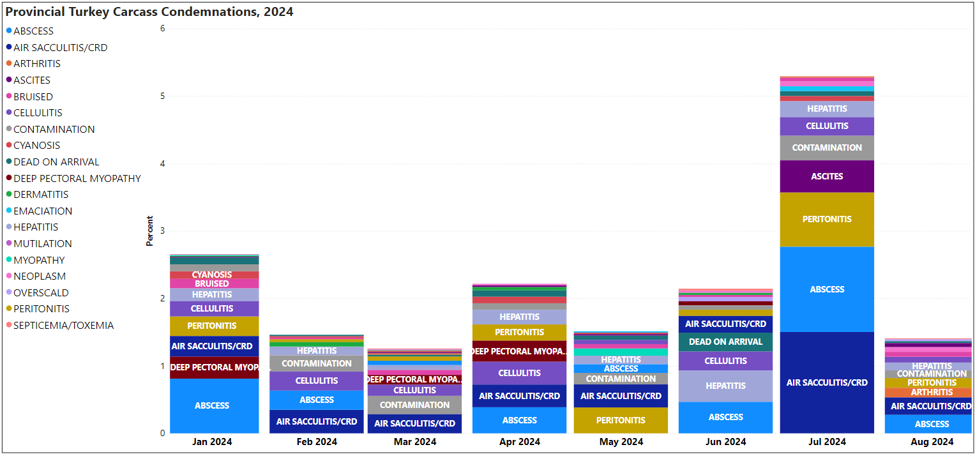

Number of turkeys slaughtered by region, Jan-Aug 2024. From CAHSS Federally Inspected Slaughter Data

Top 10 turkey post mortem condemnation conditions per 10,000 slaughtered, Feb-Aug 2024. From CAHSS Federally Inspected Slaughter Data. Subcutaneous conditions, emaciation, and “other” conditions were reported as the main conditions for condemnation for turkeys slaughtered in federally inspected plants in Ontario.
Small Flock
Chickens:
AHL: Diagnoses at AHL included lice, mites (external), intestinal parasitism (coccidiosis, heterakis, nematodes), Marek’s disease, neoplasia (adenocarcinoma), salpingitis/peritonitis, bacterial septicemia (E. coli/G. anatis), pneumonia (infectious coryza (A. paragallinarum, E. coli, S. hyicus) – sinusitis, cellulitis, keratitis, anterior uveitis), M. synoviae, egg bound (suspected), IBV, emaciation, necrotic enteritis, gizzard foreign body, ventriculitis, myositis, and hepatomegaly.
ILT: 3 cases (1 CEO/TCO vaccine-like strain TCAA cluster, 1 not sequenced, and 1 too weak to type).
Gamebird/Ratities:
AHL: One guinea fowl and 1 pheasant case submitted this quarter.
Guinea fowl: Coccidiosis.
Pheasant: Retained subcuticular yolk sac remnant with cellulitis and intestinal herniation.
Waterfowl:
AHL: Three duck cases and 1 goose case submitted this quarter.
Ducks:
1) Muscovy Duck – Foreign Body ingestion (bone shards, plastic), hemorrhagic shock, trauma (hepatic capsule tear).
2) Duck – Septicemia (P. multocida, E. coli)
3) Duck – Iridial melanocytoma, intraocular hemorrhage.
Goose: American Goose – Hepatomegaly, splenomegaly, and renomegaly.
Pigeons:
AHL: One Imperial Pied Pigeon (E. coli septicemia).
Practitioners: No information provided with the clinical impression on any of the small flock species for this quarter.
Poultry research from Ontario and beyond
- Highly Pathogenic Avian Influenza H5N1 Genotype B3.13 in Dairy Cattle: National Epidemiologic Brief (usda.gov)
- In-ovo Sexing Technologies – Laying Hens (hendrix-genetics.com)
- A New Eimeria Species (Apicomplexa: Eimeriidae) Parasitizing Commercial Chukar Partridges (Alectoris chukar) in Southern Ontario (bioone.org)
Events and News
Poultry Industry Council events: https://www.poultryindustrycouncil.ca/events
Poultry Health Research Network information, events, and lectures can be accessed on the PHRN website: https://phrn.net/ or on the PHRN YouTube channel: https://www.youtube.com/user/PoultryHRN
Thank You!
We thank the following poultry veterinarians who completed the veterinary survey:
Dr. Tim Abolarin, Dr. Elizabeth Black, Dr. Joanne Dias, Dr. Daniella Di Pirro, Dr. Fernando Salgado-Bierman, Dr. Peter Gazdzinski, Dr. Shahbaz Haq, Dr. Elana Huong, Dr. Anastasia Novy, Dr. Mike Petrik, Dr. Joanne Rafuse, Dr. Ben Schlegel, Dr. Chanelle Taylor, Dr. Brenna Tuer, Dr. Alex Weisz, and Dr. Jessalyn Walkey.
